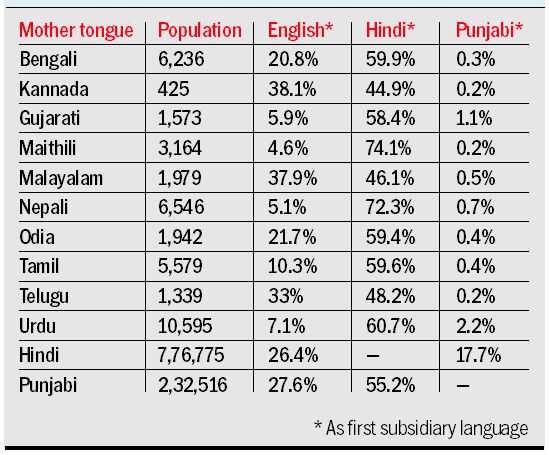Bhartesh Singh Thakur
Tribune News Service
Chandigarh, October 2
After their mother tongue, city residents are more proficient in English followed by Hindi and Punjabi. However, the percentage of people with proficiency in English has declined from 2001 to 2011.
The census report on bilingualism and trilingualism, released recently, has provided data on the two languages in order of preference in which a person is proficient other than the mother tongue. The data was collected in 2011.
An analysis of the data of the first subsidiary language brings English at the top. However, the percentage of people having proficiency in the language has dipped from close to 33 per cent in 2001 to over 26 per cent in 2011. The percentage of people with expertise in Hindi has seen a jump from 13.2 to 14.8 in 10 years. Punjabi has also seen a jump from 11 per cent to 13 per cent, but it has hardly made any connect with Maithalis, Malayalese, Bengalis, Odias and Tamils.
The highest population in Chandigarh is of those with Hindi as the mother tongue at over 73 per cent. Over 26 per cent of them returned their expertise in English, while over 17 per cent returned Punjabi. However, if we compare it with the 2001 census data, over 31 per cent were proficient in English and over 16 per cent had returned Punjabi. The expertise in English has dipped, but in Punjabi, it has marginally increased.
Among Punjabi speakers, 27.6 per cent returned English as their first subsidiary language, while those with proficiency in Hindi stand at over 55 per cent. In 2001, people with Punjabi as the mother tongue had 39 per cent population expressing proficiency in English and 40 per cent expressing more knowledge about Hindi than any other language.
So, overall Hindi expertise has risen and that in English has dipped.
Among the Tamil-speaking population, the percentage of people preferring Hindi has jumped from 42.8 in 2001 to 59.6 in 2011. On the other hand, English as the first subsidiary language has come down from 15.6 per cent to 10.3 per cent in 10 years.
On similar lines, the preference of Hindi among Telugu-speaking people has jumped to 48.2 per cent from 33.1 per cent in 10 years and that of English has reduced from 46.6 per cent in 2001 to 33 per cent.
The interest of the Malayalam-speaking population in Hindi has increased. The percentage of people preferring Hindi has jumped from 31.8 in 2001 to 46.1 in 2011. However, there is a big dip in returning English as the first subsidiary language. In 2001, it was 53.5 per cent, but it dipped to 37.9 per cent in 2011.
Punjabi has failed to attract people from other states.
“Proficiency in English is high in Chandigarh because of migration of upper and middle class people from other states. Those belonging to southern states are showing preference for Hindi because it is the link language. Punjabi is not the link language. Hindi is also compulsory in schools, so the second-generation people are more likely to return Hindi as their first subsidiary language after the mother tongue,” said Prof Aswini Kumar Nanda, Population Research Centre, Centre for Research in Rural and Industrial Development (CRRID).
Jump in People with expertise in Hindi
An analysis of the data of the first subsidiary language brings English at the top. However, the percentage of people having proficiency in the language has dipped from close to 33 per cent in 2001 to over 26 per cent in 2011. The percentage of people with expertise in Hindi has seen a jump from 13.2 to 14.8 in 10 years. Punjabi has also seen a jump from 11 per cent to 13 per cent, but it has hardly made any connect with Maithalis, Malayalese, Bengalis, Odias and Tamils.
Unlock Exclusive Insights with The Tribune Premium
Take your experience further with Premium access.
Thought-provoking Opinions, Expert Analysis, In-depth Insights and other Member Only Benefits
Already a Member? Sign In Now











